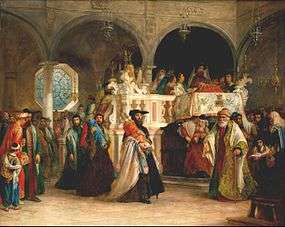Solomon Hart
Solomon Alexander Hart RA (April 1806 – 11 June 1881) was a British painter and engraver.[1] He was the first Jewish member of the Royal Academy in London and was probably the most important Jewish artist working in England in the 19th century.
Solomon Hart | |
|---|---|
 Self-portrait of Solomon Hart, c. 1860 | |
| Born | Solomon Alexander Hart 1806 Plymouth, England |
| Died | 1881 London, England |
| Education | Royal Academy of Arts |
| Known for | Painting, drawing, engraving |

Biography
He was born at Plymouth, the son of Samuel Hart (fl. 1785–1830), a Jewish engraver and teacher of Hebrew. After completing his basic education, he was apprenticed to another local engraver. Later, he became the first Jew to enroll at the Royal Academy. While there, he worked in a variety of styles from genre to historical scenes and practiced several engraving and sketching techniques. He especially excelled in miniatures.
In 1826, he débuted at one of the Academy's exhibitions with a portrait of his father. By 1840, he was successful enough to be accepted as a member of the Academy. The following year, he embarked on a study trip to Italy and spent a great deal of time in Florence. In 1854, he was appointed a Professor at the Academy.
Although his early works were largely Jewish-themed, his exposure to Italian art (especially the works of Domenico Ghirlandaio in the Ognissanti) added motifs from church and monastery paintings. He also regularly provided illustrations for periodicals such as The Athenaeum and The Jewish Chronicle.
He never married and, in his later years, gradually lost his eyesight, although he continued to paint as long as possible.
Works
- 'Othello and Iago' (1855)
- Temple of Jews at Shilo Hannah presenting infant to High Priest (1878) (sold on 16 March 1999 for £43,095 by Sotheby's New York)
- Flee Moham'mad Beg who accompanied horses presented by Ima'm of Muscat to King William IV (sold on 29 May 2000 for £29,000 by Eldreds Plymouth)
- [The Quarrel of] Wolsey and Buckingham (1834)
- Coeur de Lion and Saladin (1835)
- The Young Falconer (1835)
- Sir Thomas More receiving his Father's Blessing (1836)
- Henry I receiving News of the Shipwreck and Death of his Son (1840)
- Milton visiting Galileo in Prison (1847)
- The Feast of the Rejoicing of the Law at the Synagogue in Leghorn, Italy (1850)
- The Three Inventors of Printing (1852)
- Hop Picking (1852)
- Solomon pondering the Flight of Time (1853)
- Columbus (1854)
- Sacred Music (1860)
- Dilettanti (1861)
- Desdemona and Othello (1863)
- Benvenuto Cellini and Francis I (1864)
- The Eve of the Sabbath (1868)
- Portrait of Sir Moses Montefiore (1869)
- Oliver Cromwell and Menasseh Ben Israel (1873)
- Troy Weight (1874)
- A Reminiscene of Ravenna (1875)
- Dinner-Time at Penshurst in 1655 (1876)
- Reflection (1877)
- Perfidy (1878)
References and sources
- This article incorporates text from a publication now in the public domain: Wood, James, ed. (1907). "article name needed". The Nuttall Encyclopædia. London and New York: Frederick Warne.
- "Obituary". The Jewish Chronicle. 17 June 1881.
- Roth, Cecil (1961). Jewish Art: An Illustrated History. McGraw-Hill.
- Salaman, Malcolm (2005). Shakespeare in Pictorial Art. Kessinger Publishing. ISBN 1-4179-7027-8.
- Van Voolen, Edward (2006). Jewish art and culture. Prestel.
- Cohen, Richard I. (1998). Jewish icons. University of California Press. ISBN 0-520-20545-6.
- Ripley, George; Dana, Charles Anderson (1860). "The new American cyclopædia, ed. by G. Ripley and C.A. DanaThe new American cyclopædia, ed. by G. Ripley and C.A. Dana, American cyclopaedia". The New American Cyclopaedia. D. Appleton & Company. p. 743.
- Sandby, William (1862). The History of the Royal Academy of Arts from Its Foundation in 1768 to the Present Time. Longman.
- Valentine, Helen (2004). "Hart, Solomon Alexander (1806–1881)". Oxford Dictionary of National Biography. Oxford University Press.
External links
| Wikimedia Commons has media related to Solomon Hart. |